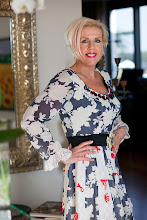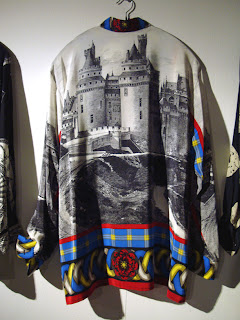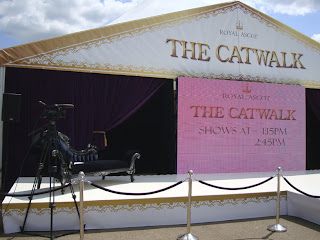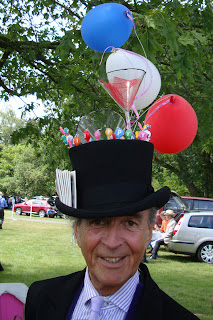
When writing a piece on 3D printing/computer generated design, I stumbled upon this quote in Michael Eden’s blog: “In an increasingly post-digital world, there is a move towards a pre-industrial landscape. Eased by global connectivity, cottage industries are sprouting up everywhere. People are creating their own products, services, and art. They are rediscovering the satisfaction of creating a tangible product, the process of making, the lessons from making by hand.”
The skilled workmanship and practical benefits of artisan crafts are becoming ever more appreciated – which is great for students about to graduate from the Royal College of Art (as illustrated in my post at The Dabbler). ShopCurious notes that the traditional snobbery surrounding art versus craft is coming under closer scrutiny too.
I wouldn’t describe myself as a designer-maker, but, I did have a go at a spot of DIY design when I contributed towards Lulu Guinness’ Be a Pin Up installation at Clerkenwell Design Week. Participative art has become a popular means of promotion for arts organizations and retailers.
In this case, the tools on offer consisted of a giant slab of metal pins that could be moulded into a shape by pressing your body against it – effectively creating a human sculpture. First I observed the technique, watching a couple of chaps do their curiously creative thing (above and left).
Then I had my own attempt. Initially a straightforward full body replica - though I didn’t appear to have any hips, and there was a large hole in my chest…
I’d really wanted to create something a little more original, so I raised one leg up as high as it would stretch and shoved my foot into the pins. I certainly created a very curious impression (see below), sustaining a bruised and bleeding shin in the process.
I was too shy to submit my feeble efforts to Lulu's contest, but it just goes to show that anyone and everyone can be a conceptual artist.
These days, 'design art' is as much about making an impression as the quality of the work itself. If you’re an aspiring artist, as in the music and film industries, you should be prepared to bare your soul in order to gain recognition…
In future, what may become more important is creating something useful. Perhaps this accounts for the burgeoning number of craft workshops and websites – and the emergence of DIY design? But a word of warning: don’t expect your handiwork to look perfect.
Will you?
Blog Archive
-
▼
2011
(113)
-
▼
June
(11)
- Design art: making an impression
- Timeless textiles
- QR coding the future of design
- Designs to drive Dad crazy
- Hats, history and racing fashion
- A curiously arty party...
- Fishing around for Father's Day?
- Champions of curious creativity
- Old fashioned seaside fun
- Her Eminence, Queen of Britart
- Dressing down for toffs?
-
▼
June
(11)
Twitter Updates
Followers
About Me

- Susan
- Curiously crazy? Curiously creative? Curiously clever? A colourful curiosity? Are you curious?
My Blog List
-
dropshipper2 years ago
-
-
I'm back!9 years ago
-
New Word : ICONATOMY12 years ago
-
Total Pageviews
Links
- BLDG BLOG
- Cabinet of Wonders
- Colin McDowell
- disneyrollergirl
- Elizabeth Avedon
- Fashion Preserve
- fredbutlerstyle
- Godammit, I'm Mad!
- Lenorenevermore
- Luxe et Vanites
- Make Do Style
- Morbid Anatomy
- Nigeness
- Outsapop Trashion
- Pretty Portobello
- Profoundly Superficial
- Race Of Style
- Random Fashion Coolness
- ruminant
- Simply Healing
- Stella's Roar
- Style Bubble
- Style Porn
- The Spectator Arts Blog
- Think of England
- Thought Experiments
Tag Cloud
Style with brains.
Monday 27 June 2011
Design art: making an impression
Friday 24 June 2011
Timeless textiles

QR codes remind me of the classical inspired look of former RCA graduate (now honorary fellow and visiting professor), Sue Timney, whose work was recently on show at London’s Fashion and Textiles Museum.
Back in the early 1980s, finding someone to buy your designs meant trekking half way around the world – in her case to Japan, where her printed silk scarves, shirts, ties, ceramics and stationery were snapped up by luxury retailers, enabling her and ex-partner, Grahame Fowler, to expand their Timney-Fowler business in the UK. Since 2001, Timney has concentrated mainly on private and commercial interiors projects, and is known for her distinctive monochrome styling. She’s also designed restaurants and styled Joseph’s interior shop, ‘Pour la Maison.’



The exhibition featured a lot of her 1990s work, which was developed for fashion and interiors, using images recurring throughout the cut out work of Timney Fowler – statues, architectural details, cutlery, furniture, clocks, musical instruments, animals, heraldic symbols, kitchen implements and decorative frames.



Clocks and clock faces have been something of a trademark of her style between 1985 and 2010. Many of the clock images are based on an original art deco railway clock, which was also on show at the exhibiton. Astronomy is another theme she’s interpreted in her uniquely bold manner.




Emma Shipley’s printed textiles, currently on display at the RCA show, are equally stunning. Her drawings are inspired by botanical illustrations. Some are drawn by hand using graphite pencil on hot pressed paper to assure a ‘quiet asymmetry’, and other designs are developed using a computer, programmed to incorporate a random element into the process.


As it happens, founder of the Fashion and Textiles Museum, fashion designer Zandra Rhodes, is also an RCA graduate. And, if you’re looking to invest in a piece of vintage textile design, we’ve a curiously collectable 1970s Zandra Rhodes painted lady silk scarf at ShopCurious.
Are you?
Thursday 23 June 2011
QR coding the future of design

The Royal College of Art’s graduate show, Show RCA 2011, starts tomorrow. Billed as ‘a must see event for anyone interested in 21st century art and design,’ the description fails to convey the breathtaking creativity and innovative genius of the designers whose work is on display.
This year, a unqiue QR code is incorporated into the details of each of the 431 students works, linking to their relevant page in an online catalogue, their Linkedin profiles and CVs.
What we may eventually discover is that blown up versions of QR codes are great as works of art in their own right, especially as the monochrome look is so popular in interior styling these days - and mosaics are also experiencing something of a revival.
ShopCurious spotted this fabulous fashion inspired QR piece (left), please let us know if you have any information on the artist.
RCA exhibitor Thorunn Arnadottir’s designs incorporate both QR technology and mosaics. Her project explores ‘the juxtaposition of fame and personal privacy in the new environment.’ By fusing ancient African methods - beads for communication and masks that project identity with modern technology - she proposes a way of channeling the current obsession with vanity and fame, to the benefit of NGOs and charitable organizations.
But she’s also created this ‘super-self-promotional dress’ for a pop star Kali in Steed Lord (see below). The curiously clever fashion statement is composed of QR codes that link to online promotional material, which can be viewed instantly on fans’ mobile phones.
I'm not sure if Kali really needs the dress...
Are you?
Sunday 19 June 2011
Designs to drive Dad crazy

Happy Father’s Day! How about a spot of auto porn to spice up Dad’s special day… ShopCurious has put together a selection of car photos taken in and around London, where everything to do with cars is suddenly in fashion.
First, as part of Westminster’s Festival of Sculpture, Lorenzo Quinn’s Vroom Vroom appeared in Park Lane. The unique sculpture features a giant hand, holding a full size Fiat 500.
Then, at Clerkenwell Design Week, sponsored by Jaguar, a number of top of the range cars were on display – including the beautifully designed C-X75 concept car (below).

I had my eye on something a little more eco-friendly. When Office Electrics pedal car came by, I simply had to try it out. It’s powered purely by leg-work, but there are solar panels to provide green energy for extras, like music.

I wasn’t exactly dressed for cycling, but it looked such fun aboard the pedal car that I threw caution to the wind. This video clip gives an idea of what it was like riding up the Clerkenwell Road on the curiously communal car:

Vintage cars often pop up at summer society events. A retro Morris Minor was on show at Chelsea Flower Show.
And this fabulously old fashioned Roller (below left) added a touch of character to the car park at Royal Ascot, reminding me of racing picnics from a bygone era.



By the way, a seriously cool car comes up for sale at Chiswick Auction rooms on 28th June – I simply love this replica of John Lennon’s hand painted hippie style Royce. Forget about Dad, I rather fancy a car like this myself...
Do you?
Wednesday 15 June 2011
Hats, history and racing fashion

Styles have changed dramatically over the past 300 years, but the tradition of the Royal Ascot race meeting has remained an annual fixture of the summer social season. The event has become an occasion for racegoers from all over the world to indulge in a little English eccentricity – wearing quirky hats, unique accessories and curiously original clothing.
I’m not sure whether Royal Ascot has always been as much about the fashion as the horse racing, but photographic evidence from past decades shows that dressing up has certainly been a major part of proceedings.
In celebration of the 300th Anniversary of Royal Ascot, the display of vintage photographs of royals and celebrities at the event includes this stylish shot of Sophia Loren in a wonderfully wide brimmed hat - along with pictures of some of the more curious clothing, like these over-the-top outfits from the ‘swinging sixties’:

Nowadays with catwalk shows, a Fashion Bar and live televised fashion commentary, Royal Ascot has become a firm favourite with fashionistas and designers alike.

Like most women, I'm not so much interested in the racing as the parade of hats, handbags and amazing attire on show. Apart from the official dress code, the way people choose to ‘dress up’ is a matter of personal taste... On the first day, yesterday, I noticed that flowers were very much in fashion.

I wore Vivienne Westwood with a recycled hat, accessorized with a floral hairslide, found in a drawer just before I left. I jazzed up my look with quirky '70s style snakeskin shoes, a vintage basket bag and a tasseled natural stone necklace from ShopCurious – worn sideways, of course.

Some ladies opted for the retro look – from 1930s floaty tea dress to 1950s prom style.

Others were more fashion forward, like Vivienne Westwood's head of couture, in a futuristic flying saucer hat by Philip Treacy – and a rather arty looking Aussie visitor.

One lady definitely stood out from the crowd in a pearl encrusted, rose-adorned Marie Antoinette style wig. A simple, cat-eared hat by Stephen Jones was also rather different from the mainstream.

Men are able to express their individuality at Royal Ascot too. Photographer, Francis Mander, arrived looking as though he was ready for a spot of farming. And one chap, wearing a pith helmet, had obviously got on the wrong ‘plane.

Some wore exotic headgear and brightly coloured waistcoats.

And David Shilling’s Royal Ascot birthday tribute topper was madly marvellous.

From old to new, there were some blinging accessories on show as well - from rhinestone bejewelled antique watches to crystal covered mobile 'phones.


Best of all, it was a lovely sunny day, and everyone seemed to be smiling…
Are you?





